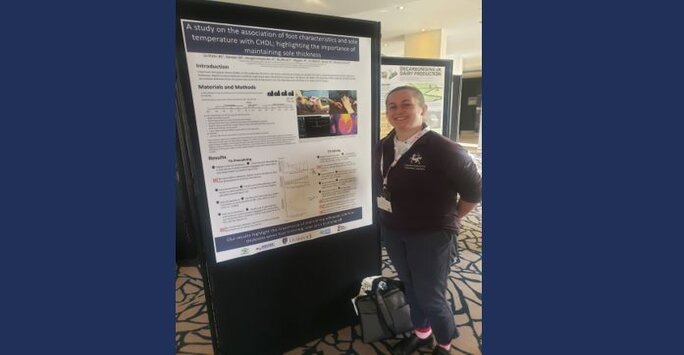
Bethany Griffiths is a final year PhD student in the Department of Livestock and One Health in the Institute of Infection, Veterinary and Ecological Sciences (IVES). Last month, she attended the Total Dairy Conference 2023 in Stratford-Upon-Avon and here tells us about her research and the results presented at the conference.
Prior to my PhD, I graduated as a Veterinary Surgeon, having intercalated during my studies to obtain a Masters of Research in Clinical Science. My PhD is part of a wider project which examines the genetic association with cattle lameness and my project aims to bring together the current theories regarding the cause and development of claw horn disruption lesions and test them in a single cohort of dairy cattle across four farms.
Background
Lameness in dairy cattle is prevalent, with approximately a third of dairy cattle lame in the UK at any one time. Lameness is associated with a host of negative effects; not only is it a welfare concern but it also severely limits production in the dairy industry. Claw horn disruption lesions is the collective term for non-infectious lesions of the foot, which include some of the most common and most severe lameness causing lesions.
My research
The first paper from my project aimed to examine the role of foot characteristics and conformation in the development of claw horn disruption lesions.
I was able to work with a fantastic team of fellow PhD students, research assistants, and veterinary students who worked together to collect a vast array of information. We enrolled 2,352 cows prior to calving and followed these animals over the course of a lactation. At key time points, we collected a host of information regarding their foot characteristics and conformation, alongside the energy, hormonal, and inflammatory status of these animals.
Our findings highlighted the significance of the cushy pad of fat and fibrocartilage in a cow's hoof and the differences in how sole ulcers, sole hemorrhage, and white line lesions develop.
We didn’t find a link between foot angle and heel depth in causing sole or white line lesions but what we did find was that a thicker sole is associated with lesion development and so it’s important to prioritise preventative foot trimming. We also discovered that the temperature of the sole before and shortly after calving is connected to the development of lesions in the early lactation period.
Conference presentation
The first results from this project have recently been presented at Total Dairy, which is a dairy industry conference designed to share new research and current best practice with progressive forward-thinking farmers and industry stakeholders.
This research has subsequently been accepted for publication and can be found here: A prospective cohort study examining the association of claw anatomy and sole temperature with the development of claw horn disruption lesions in dairy cattle.